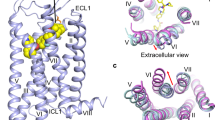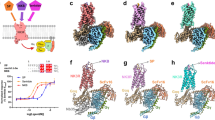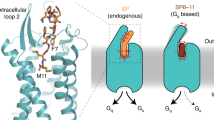Abstract
NON-PEPTIDE ligands for peptide receptors have been discovered in several systems through file screening programs1–6, but the mechanism of action for these candidate drugs is obscure as they do not chemically resemble the native peptides. The compound CP 96345 is a high-affinity, non-peptide antagonist of the substance P (NK1) receptor4,5,7, which is important in pain perception and neurogenic inflammation8–11. Here we identify epitopes on the NK1, receptor responsible for the specific binding of CP 96345 by systematic exchange of corresponding segments between the NK1, receptor and the homologous NK3 (neurokinin B) receptor, which does not bind the non-peptide ligand. Non-conserved residues, in two epitopes around the top of transmembrane segment V and in one epitope at the top of transmembrane segment VI, are essential for the specific action of CP 96345 on the NK1, receptor, but are surprisingly not important for the binding of the natural peptide ligand, substance P. Susceptibility to the non-peptide antagonists can be conveyed to the previously unresponsive NK3 receptor by mutational transfer of this discontinuous epitope from the NK1, receptor.
This is a preview of subscription content, access via your institution
Access options
Subscribe to this journal
Receive 51 print issues and online access
$199.00 per year
only $3.90 per issue
Buy this article
- Purchase on Springer Link
- Instant access to full article PDF
Prices may be subject to local taxes which are calculated during checkout
Similar content being viewed by others
References
Freidinger, R. M. et al. in Neuropeptides and their Receptors (eds Schwartz, T. W., Hilsted, L. M & Rehfeld, J F.) 389–400 (Alfred Benzon Symposium 29, Munksgaard. Copenhagen, 1990).
Chang, R. S. L., & Lotti, V. J. Molec. Pharmac. 29, 347–351 (1989).
Dudley, D. T. et al. Molec. Pharmac. 38, 370–377 (1990).
Snider, R. M. et al. Science 251, 435–437 (1991).
McLean, S. et al. Science 251, 437–439 (1991)
Yamamura, Y. et al. Science 252, 572–574 (1991).
Snider, R. M., Longo, K. P., Drozda, S. E., Lowe, III J. A. & Leeman, S. E. Proc. natn. Acad. Sci. U.S.A. 88, 10042–10044 (1991).
Pernow, B. Pharmac. Rev. 35, 85–141 (1983).
Buck, S. H. & Burcher, E. Trend pharmac. Sci. 7, 65–68 (1986).
McGillis, P., Mitsuyashi, M. & Payan, D. G. Ann. N Y. Acad Sci. 594, 85–94 (1990).
Iversen, L. L., McKnight, A. T., Foster, A. C., Young, S. C. & Williams, B. J. in Neuropeptides and their Receptors (eds Schwartz, T. W., Histed, L. M. & Rehfeld, J. F.) 363–372 (Alfred Benzon Symposium 29, Munksgaard, Copenhagen, 1990).
Yokota, Y. et al. J. biol. Chem. 264, 17649–17652 (1989).
Shigemoto, R., Yokota, Y., Tsuchida, K. & Nakanishi, S. J. biol. Chem. 265, 623–628 (1990).
Engberg, G., Svensson, TI H., Rosell, S. & Folkers, K. Nature 293, 222–223 (1981).
Mizrahi, J., Escher, E., D'Orleans-Juste, P. & Regoli, D. Eur. J. Pharmac. 99, 193–202 (1984).
Laufer, R. et al. Proc. natn. Scad. Sci. U.S.A. 82, 7444–7448 (1985).
Kobilka, B. K. et al. Science 240, 1310–1316 (1988).
Dohlman, H. G., Thorner, J., Caron, M. G. & Lefkowitz, R. J. A. Rev. Biochem. 60, 653–688 (1991).
Frielle, T., Daniel, K. W., Caron, M. G. & Lefkowitz, R. J. Proc. natn. Acad. Sci. U.S.A. 85, 9494–9498 (1988).
Wess, J., Gdula, D. & Brann, M. R. Molec. Pharmac. 41, 369–374 (1992).
Dixon, R. A. F. et al. Nature 326, 73–77 (1987).
Strader, C. D. et al. J. biol. Chem. 263, 10267–10271 (1988).
Wess, J., Gdula, D. & Brann, M. R. EMBO J. 10, 3729–3734 (1991).
Johansen, T. E., Vogel, C. & Schwartz, T. W. Biochem. biophys. Res. Commun. 172, 1384–1391 (1990).
Sanger, F., Nicklen, S. & Coulson, A. R. Proc. natn. Acad. Sci. U.S.A. 74, 5463–5467 (1977).
Johansen, T. E., Schøller, M. S., Tolstoy, S. & Schwartz, T. W. FEBS Lett. 267, 289–294 (1990).
Gether, U., Marray, T., Schwartz, T. W. & Johansen, T. E. FEBS Lett. 296, 241–244 (1992).
Fong, T. M., Huang, R. C. & Strader, C. D. J. biol. Chem. 267, 25664–25667 (1992).
Author information
Authors and Affiliations
Rights and permissions
About this article
Cite this article
Gether, U., Johansen, T., Snider, R. et al. Different binding epitopes on the NK1 receptor for substance P and a non-peptide antagonist. Nature 362, 345–348 (1993). https://doi.org/10.1038/362345a0
Received:
Accepted:
Published:
Issue Date:
DOI: https://doi.org/10.1038/362345a0
This article is cited by
-
Evaluation of Receptor Affinity, Analgesic Activity and Cytotoxicity of a Hybrid Peptide, AWL3020
International Journal of Peptide Research and Therapeutics (2020)
-
Crystal structures of the human neurokinin 1 receptor in complex with clinically used antagonists
Nature Communications (2019)
-
The role of substance P in stress and anxiety responses
Amino Acids (2006)
Comments
By submitting a comment you agree to abide by our Terms and Community Guidelines. If you find something abusive or that does not comply with our terms or guidelines please flag it as inappropriate.



